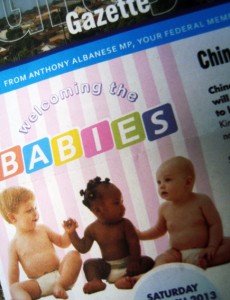Much has been said about the impact of digital technology and social media on the political process, from the Arab Spring protests to President Obama’s election campaigns, but the fact is that politicians still love print, and printers love politicians too (when they are printing).
For the politicians, print is a means of communicating directly to constituents without any interference from those dastardly press people or TV hosts. Radio and television are broadcast media but direct mail speaks straight to the locality. And because it’s print, the chances are that, if it is done well, it has a much higher chance of being read and retained.
And the best part? It’s all paid for by the taxpayers anyway. Just part of the service.
Under the Howard government, the taxpayers’ largesse reached new heights with each MP’s allowance increased to $150,000 per annum with the added proviso that up to $67,500 of unspent allowance could be rolled over into the following year. Very handy for funding election campaigns.
Not surprisingly there were accusations of rorting and misuse which, in a display of impressive originality, came to be dubbed ‘Printgate’ by the then Queensland Premier, Peter Beattie.
When the Rudd government came to power, the printing allowance was cut to $100,000 and, in 2009, slashed to a miserly $75,000, much to the disgruntlement of certain Labor MPs. Not that complaining gained them anything apart from experiencing first-hand the effects of the Rudd blowtorch.
And that’s where the situation currently resides. Or does it? According to the Department of Finance and Deregulation, the current parliamentary printing and communication entitlements cover:
- Cost of commercial services for printing and production of e-material (including design, artwork, photography and translation) for parliamentary or electorate purposes, distribution of printed and e-material, and the establishment and maintenance of websites to the value of the standard rate of postage ($0.60) multiplied by the number of enrolled voters in the Member’s electorate plus $75,000 per year.
So, for example, in the electoral division of Fraser in the ACT which had 133,488 voters enrolled at the end of 2012, the allowance would be over $155,000 – exceeding the limit set by John Howard. The average division of about 94,000 voters works out at an allowance of $131,400 per year.
Of course, this figure also covers the production and distribution of ‘e-material’ such as websites, Facebook advertising, social media monitoring and email campaigns but there is no guidance as to how much of the allowance can be spent on these media. The digitally illiterate, for instance, could presumably spend all their allowance on flyers and fridge magnets.

In the year ending June 2012, the member for Grayndler, Anthony Albanese, from whom this particular newsletter was issued, spent a total of $152,000 on office administrative costs which includes printing and communications as well as items including ‘office requisites and stationery, office equipment, office expenses, publications’. Some of these items also have their own allowances.
According to the departmental guidelines, selection of printers used for material such as this newsletter should be based on “value for money, open and effective competition, ethics and fair dealing, accountability and transparency”. In reality, some politicians make no secret of the fact that they like to pop down to their local printer and spread a little of their largesse. It’s called ‘supporting small business’ or ‘investing in Australian manufacturing’. And that’s why printers love politicians who love to print.
In this case, these four full colour A4-pages were printed by Inpress Printing based in Condell Park, NSW.


